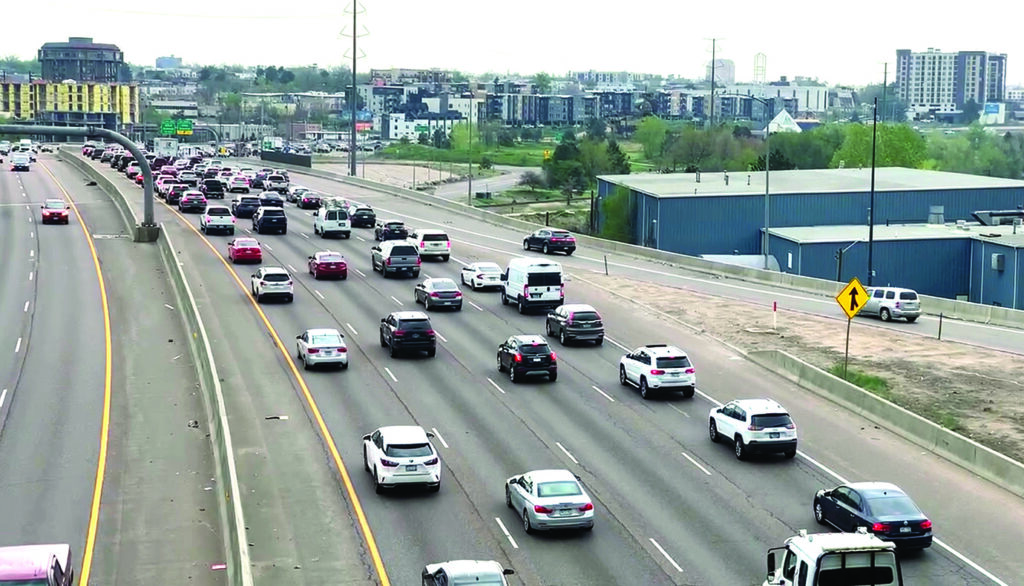
The Colorado Department of Transportation (CDOT) has its sights set on a revamp of Interstate 25 in Central Denver from the Valverde neighborhood on the South to the Highland neighborhood in the North.
CDOT is looking at the next phase of changes for the stretch road that often carries 200,000+ vehicles per day. Three years in the making, CDOT completed the Central Planning and Environmental Linkages Study (PEL) in late 2020. “This is a study that identified causes of congestion and considered options to improve safety, travel and reliability along a 4.5 mile segment of I-25 between Santa Fe Drive and 20th Street” explained CDOT Communications Manager Tamara Rollison.
A master plan of sorts for the interstate, the PEL looks at reducing congestion among other goals. In particular, northbound travel between Broadway and Park Avenue sees an average of 18 minute delays during the evening rush hour, and southbound travel sees delays of around 8 minutes on the same stretch during the evenings. The PEL lists 4 future alternatives ranging from doing nothing to I-25 and focusing on improvements to nearby arterial streets on one end of the spectrum to expanding the highway and adding a new lane in each direction. These new lanes would be toll and/or HOV lanes, called managed lanes. The analysis also mentions the potential expansion of multimodal options like increased transit options as well as improved pedestrian and bike infrastructure going North/South and also East/West across the corridor. Choosing the final alternative, timeline, and total cost for the Central I-25 project is still in progress.
The study also looks at bringing some of the older exit/entrance ramps like 23rd Avenue and the Speer Boulevard interchange up to more modern standards as well as replacing those bridges, two of the oldest in the area. The 23rd Avenue and Speer bridges have the lowest height clearance of any bridges along I-25, creating a barrier to over-height vehicles that are forced to divert to longer alternate routes. There are also occasional bridge collisions with trucks themselves or oversized cargo.
Even though the final alternative design for the Central I-25 project has not been chosen yet, work on replacing those two bridges and interchanges at Speer and 23rd Avenue will likely begin in the next decade, as it is on CDOT’s 10 year strategic project pipeline. The estimated cost for this portion of the project is $85,000,000 and CDOT has identified funding for a portion of that in the next 5-10 years.
Some advocacy groups are concerned about the potential expansion of the interstate being on the table as one of the options. Ean Thomas Tafoya, Colorado State Director for GreenLatinos, who was invited to participate in the PEL process, has concerns about expanding the interstate. “We know that highway widening and induced demand are a real thing. They continue to think that widening is going to solve these problems.” Induced demand is the concept that increasing capacity of a road will encourage more people to drive, perpetuating congestion. The last major I-25 expansion project, TREX, widened I-25 in the southern part of Denver. Only a few years after the project was finished, congestion levels were just as bad as they were before construction started.
Tafoya noted that air pollution for communities living near the highway is harmful. “There is no doubt there is a direct link from small particulate matter both from industrial and car pollution leading to adverse respiratory outcomes and heart disease for people in these communities.” Tafoya’s major complaint about the current process for potentially expanding interstates is that CDOT looks at making the interstate safer and more efficient for drivers, but doesn’t take into account how expanding the interstate will have adverse public health impacts for air pollution in surrounding communities from tailpipe emissions including ozone, particulate matter, as well as climate change. “It’s always about travel times, but it doesn’t talk about climate and it doesn’t talk about air pollution in a meaningful way that makes sense for my community. I’ve not seen any studies that show a reduction in pollution factors once the highway is filled up again…no highway widenings are in alignment with our climate goals.”
When asked about air pollution, CDOT spokesperson Rollison replied “Regarding air quality impacts, they are certainly considered in the evaluation of alternatives and in the environmental process. Final evaluation of alternatives will include consideration of GHG emissions.”
Originally known as the “Valley Highway,” construction on I-25 began in 1948, and required bulldozing homes and displacing residents in working class North Denver neighborhoods to make way for the new interstate. It was fully opened in 1958 and featured two lanes in each direction.
Since then, there have been a lot of updates to the road and at least one incident provided some momentum for change. On August 1 of 1984, a truck carrying half a dozen US Navy Torpedoes overturned at the intersection of I-25 and I-70, with torpedoes leaking an unknown liquid that caused chaos and left Denver traffic at a standstill for 8 hours. The incident helped motivate an update to the I-25 and I-70 intersection known locally as the “mousetrap” over the course of the next decade because of its then sharp curves and non-conforming design that often caused traffic issues.
The highway has had numerous major construction projects over the years and has since been expanded to four lanes in either direction through North Denver. Notably, the Park Avenue Flyover bridge that connected downtown to Northbound I-25 was completed in 1998, the Highland Pedestrian Bridge was completed in 2006 along 16th St. over I-25, and the “Bronco Arch” Bridge next to the football stadium was reconstructed in 2013 along with the 15th St. Bridge.

Be the first to comment